QUESTIONS
SECTION I (50 marks)
Answer all the questions in this section in the spaces provided.
- The length and width of a rectangle measured to the nearest millimetre are 7.5cm and 5.2cm respectively. Find, to four significant figures, the percentage error in the area of the rectangle. (3 marks)
- Simplify
 (3 marks)
(3 marks) - In the figure below, O is the centre of the circle which passes through the points T, C and D. Line TC is parallel to OD and line ATB is a tangent to the circle at T. Angle DOC = 36o.
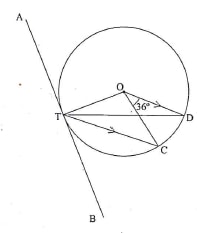
Calculate the size of angle CTB. (3 marks) - A tea dealer mixes two brands of tea, x and y, to obtain 35kg of the mixture worth Ksh 62 per kg. If brand x is valued at Ksh 68 per kg and brandy at Ksh 53 per kg, calculate the ratio, in its simplest form, in which the brands x and y are mixed. (2 marks)
- The length of a flower garden is 2m less than twice its width. The area of the garden is 60m2. Calculate its length. (3 marks)
- Five people can build 3 huts in 21 days. Find the number of people, working at the same rate that will build 6 similar huts in 15 days. (2 marks)
- When Ksh 40 000 was invested in a certain bank for 5 years it earned a simple interest of Ksh 3 800.
Find the amount that must have been invested in the same bank at the same rate for 71/2 years to earn a simple interest of Ksh 3 420. - The heights, in centimetres, of 100 tree seedlings are shown in the table below.
Find the quartile deviation of the heights. (4 marks)Height(cm) 10-19 20-29 30-39 40-49 50-59 60-69 Number of seedlings 9 16 19 26 20 10 - A bag contains 2 white balls and 3 black balls. A second bag contains 3 white balls and 2 black balls. The balls are identical except for the colours. Two balls are drawn at random, one after the other from the first bag and placed in the second bag. Calculate the probability that the 2 balls are both white. (2 marks)
- The points O, A and B have the coordinates (0,0),(4,0) and (3,2) respectively. Under a shear represented by the matrix (10 k1), triangle OAB maps onto triangle OAB'.
- Determine in terms of k, the x coordinate of point B'. (2 marks)
- If OAB' is a right angled triangle in which angle OB'A is acute, find two possible values of k. (2 marks)
- A particle starts from O and moves in a straight line so that its velocity V ms-1 after time t seconds is given by V = 3t - t2. The distance of the particle from O at time t seconds is s metres.
- Express s in terms of t and c where c is a constant. (1 mark)
- Calculate the time taken before the particle returns to O. (3 marks)
-
- Expand and simplify (2 - x)5. (2 marks)
- Use the first 4 terms of the expansion in part (a) above to find the approximate value of (1.8)5 to 2 decimal places. (2 marks)
-
- Using line AB given below, construct the locus of a point P such that <APB = 90o. (1 mark)

- On the same diagram locate two possible positions of point C such that point C is on the locus of P and is equidistant from A and B. (2 marks)
- Using line AB given below, construct the locus of a point P such that <APB = 90o. (1 mark)
- Make x the subject of the equation: (3 marks)

- Find the value of x given that
log(15 - 5x) - 1 = log(3x - 2) (3 marks) - The circle shown below cuts the x-axis at (-2,0) and (4,0). It also cuts y-axis at (0,2) and (0,-4)
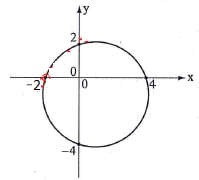
Determine the:-
- coordinates of the centre; (1 mark)
- radius of the circle. (1 mark)
- Equation of the circle in th form x2 + y2 + ax + by = c where a, b and c are constants. (2 marks)
-
SECTION II (50 marks)
Answer any five questions in this section in the spaces provided.
-
- Complete the table below, giving the values correct to 2 decimal places. (2 marks)
xo 0o 20o 40o 60o 80o 100o 120o 140o 160o 180o Cos xo 1.00 0.94 0.77 0.50 -0.17 -0.77 -1.00 Sin xo - Cos xo -1.00 -0.60 0.37 0.81 1.37 1.28 1.00 - On the grid provided and using the same axes, draw the graphs of y = cos xo and y = Sin xo - Cos xo for 0o ≤ xo ≤ 180o. Use the scale; 1 cm for 20o on the x-axis and 4 cm for 1 unit on the y-axis. (5 marks)
- Using the graph in part (b);
- solve the equation sin xo - cos xo = 1.2; (1 mark)
- Solve the equation cos xo = 1/2sin xo; (1 mark)
- determine the value of cos xo in part (c)(ii) above. (1 mark)
- Complete the table below, giving the values correct to 2 decimal places. (2 marks)
- In the figure below OJKL is a parallelogram in which OJ = 3p and OL = 2r.

- If A is a point on LK such that LA = 1/2AK and a point B divides the line JK externally in the ratio 3:1, express OB and AJ in terms of P and r. (2 marks)
- Line OB intersects AJ at X such that OX = mOB and AX = nAJ.
- Express OX in terms of p, r and m. (1 mark)
- Express OX in terms of p, r and n. (1 mark)
- Determine the values of m and n and hence the ratio in which point X divides line AJ. (6 marks)
- The positions of three ports A,B and C are (34oN,16oW),(34oN,24oE) and (26oS, 16oW) respectively.
- Find the distance in nautical miles between:
- Ports A and B to the nearest nautical miles; (3 marks)
- Ports A and C. (2 marks)
- A ship left Port A on Monday 1330h and sailed to Port B at 40 knots.
Calculate:- the local time at port B when the ship left Port A; (2 marks)
- the day and the time the ship arrived at port B. (3 marks)
- Find the distance in nautical miles between:
- A carpenter takes 4 hours to make a stool and 6 hours to make a chair. It takes the carpenter and at least 144 hours to make x stools and y chairs. The labour cost of making a stool is Ksh 100 and that of a chair is Ksh 200. The total labour cost should not exceed Ksh 4 800. The carpenter must make at least 16 stools and more than 10 chairs.
- Write down inequalities to represent the above information. (3 marks)
- Draw the inequalities in (a) above on the grid provided. (4 marks)

- The carpenter makes a profit of Ksh 40 on a stool and Ksh 100 on a chair.
Use the graph to determine the maximum profit the carpenter can make. (3 marks)
- A hall can accommodate 600 chairs arranged in rows. Each row has the same number of chairs. The chairs are rearranged such that the number of rows are increased by 5 but the number of chairs per row is decreased by 6.
- Find the original number of rows of chairs in the hall. (6 marks)
- After the re-arrangement 450 people were seated in the hall leaving the same number of empty chairs in each row. Calculate the number of empty chairs per row. (4 marks)
- The first term of an Arithmetic Progression (A.P) with six terms is p and its common difference is c. Another A.P with five terms has also its first term as p and a common difference of d. The last terms of the two Arithmetic Progressions are equal.
- Express d in terms of c. (3 marks)
- Given that the 4th term of the second A.P exceeds the 4th term of the first one by 11/2, find the values of c and d. (3 marks)
- Calculate the value of p if the sum of the terms on the first A.P. is 10 more than the sum of the terms of the second A.P. (4 marks)
- In a uniformly accelerated motion the distance, s metres, travelledin time t seconds varies partly as the time and partly as the square of the time. When the time is 2 seconds, the distance travelled is 80 metres and when the time is 3 seconds, the distance travelled is 135 metres.
- Express s in terms of t. (5 marks)
- Find:
- the distance travelled in 5 seconds; (2 marks)
- the time taken to travel a distance of 560 metres. (3 marks)
- In the figure below, P, Q, R and S are points on the circle centre O. PRT and USTV are straight lines. Line USTV is a tangent to the circle at S, <RST = 50o and <RTV = 150o.

- Calculate the size of:
- <ORS; (2 marks)
- <USP; (1 mark)
- <PQR (2 marks)
- Given that RT = 7cm and ST = 9cm, calculate to 3 significant figures:
- the length of line PR; (2 marks)
- the radius of the circle. (3 marks)
- Calculate the size of:
MARKING SCHEME
- (7.55 × 5.25) - (7.45 × 5.15) × 100
2 × 7.5 × 5.2
= 1.628% - 4 - 3
√5 + √2 √5 - √2
= 4(√5 + √2) (√5 - √2)
=4√5 - 4√2 - 3√5 - 3√2
5-2
= √5 - 7√2
3 - <OCT = 36°
<OCT = 36°
<OCT = 90 - 36°" 54°
OR = 108° = 54°
2 - 68 X + 53Y = 62
X+Y
6X - 9Y
X : Y = 9:6
= 3:2 - let length be X
Length = 2x
Area = (2 x 2s =60
X - x - 30 = 0
(x-6)(x+5) = 0
x = 6 - One person can build 1/5 x 3 huts in 21 days
10 people can build 6 huts in 21 days
2 people could lid 6 lids in 15 days
x = 21 x P 6/3 x 21/15 x 5
= 14 people - = 4000 X R x
R= 3800 = 1.9%
2000
r = 1.9%
3420 = p x 1.9 x 7.5
100
P = 3420 x 100
1.9 x 7.5
= 24000 -
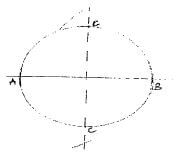
- Locus of P Drawn. B1
- + bisector of AB Constructed B1
- Position of indicated in places B1
3marks
- 3y- Y = P
Q+1/x
2y ( q+1/x) = p
q +1/x = p/2y
1/x = p/2y - q
X = 2y - Log (15-5x) = log (3x-2)
15-5x = 3x - 2
10
15-5x = 30x - 20
x = 1 -
-
- Coordinates of centre (1,-1)
- radius ; r2 = 12 +32 = 10
=r√3.162 Or = √10
Accept it
- equation:
(x - 1)2 +(y+1)2 = 10
X2 -2x + 1+ y2 + 2y +1 = 10
x2 + y2 - 2x +2y = 8
-
-
-
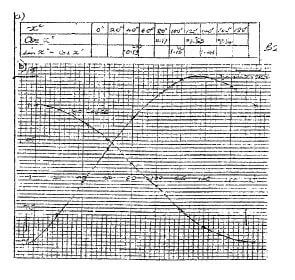
-
- Sin xº -Cos xº = 1.2
xº = 103 +1º; 167º +1 - Cos xº = 1/2sin xº
=cos xº = sin xº - cos xº
= 63º +1° - Cos 63 = 0.45+ - 0.01
- Sin xº -Cos xº = 1.2
-
-
- OB = 3P + 3r
AJ = 2P - 2R -
- OX = m(08) = m (3p+3r)
3mp2 +3mr - OX = 2r+p+n (2p-2r)
= (1 +2n) p+(2-2nr +p+2np
3mp+3mr - r(2 - 2n) + P(1+ 2n)
3m = 1 + 2n..... (i)
3m = 2 - 2n ........(ii)
1+ 2n 2-2n
4n = 1 n =3/4
Subst for n= 1/4 in (i)
3m = 1+2x1/4
3m = 1/2 = m = 3 = 1
2x3
The ratio in which x divides AJ
AX = nAJ = 1/4AJ
Ratio 1:3
- OX = m(08) = m (3p+3r)
- OB = 3P + 3r
-
-
- Angle subtended (longitude)
= 16 + 24 = 40°
AVC AB = 60 × 40× Cos 34°
= - 1989.69 1990mm - Arc AC: latitude difference
= 26+ 34 = 60°
Arc AC = 60 × 60 NM
= 3500
- Angle subtended (longitude)
-
- treal tiem at B
1330 + 40 H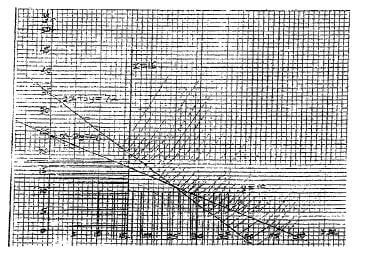
15
1330 + 2 h 40 min
= 1610h - Time taken to travel from A to B
= 1990
40
= 49 H 45 min
Time of arrival
Wednesday at 1610 +1 h 45 min
= Wed at 1755h
- treal tiem at B
-
-
- 4x+6y ≥ 144
100 x + 200y ≥ 4800
x ≥ 16
y > 10 - 2x + 3y ≥ 72 drawn & shaded
X + 2Y ≥ 48 drawn & shaded
X ≥ 16
Y > 10
At least 2 visible points inspected or search the drawn substituting in equation
- 4x+6y ≥ 144
-
- 1ct number of rows be and number of persons per row be p
Pr = 600
(r+ 5) (p-6) = 600
(r+5) (600 - 6) = 600
(r+5) (600 - 6) = 600
r
(r + 5) (600 - 6r) = 600r
600r - 6r2 + 3000 - 30r = 600r
r2 + 5r - 500 = 0
(r+25) (r-20) = 0
r = 20 - No of rows in new arrangement
20 + 5 = 25
No. of empty spaces per row with 450 people sealed
600 - 450
= 150
25
= 6
- 1ct number of rows be and number of persons per row be p
-
- T6 = p +5c
T5 = P + 4d
P+4d = p +5C
4d = 5c
d=5/4c - P+3d -(p+ 3c ) = 11/2
3d-3C = 11/2
15c - 3c = 11/2
3/4c = 3/2 = c = 2
d = 21/2 - S2 = 1/2n(2p + 10) =2.5 (2p+10)
= 5p+ 25
(6p +30) - (5p +25) = 10
P+5 = 10
P = 5
- T6 = p +5c
-
-
- S= at+bt2
80 = 2a + 4b.....(i)
135 = 3a + 9b.....(ii) - x 2 → 270 = 6a + 18b
X3 → 240 = 6a + 12b
30 = 6b = b = 5
Substitute for b = 5 in (i)
80 = 2b + 4 x 5
60 = 2a = a = 30
Expression : 5 = 30t + 5t2
- S= at+bt2
-
- Distance when t = 5 seconds
S = 30 x 5 + 5 x 25
= 275m - 560 = 30t + 5t2
5t2 + 30t -560 = 0
T+6t - 112 = 0
(t + 14) (t-8) = 0
Time taken, t = 8 seconds
- Distance when t = 5 seconds
-
-
-
- < OSR = 90-50 = 40
- <USP - 30°
+50° = 80° - < PSR = 50°
- < POR = 180°-50° = 130°
-
- PT X TR = TS2
(7+X) (7) = 92
7x = 81-49 = 32
x = 32 = 4.57
7 - 4.57 = 25
Sin°
r= 4.57
2 sin°
- PT X TR = TS2
-
Download KCSE 2010 Mathematics Paper 2 Questions with Marking Scheme.
Tap Here to Download for 50/-
Get on WhatsApp for 50/-
Why download?
- ✔ To read offline at any time.
- ✔ To Print at your convenience
- ✔ Share Easily with Friends / Students

